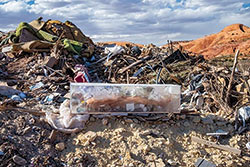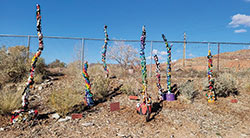art (noun) ärt: the conscious use of skill and creative imagination especially in the production of aesthetic items. Art can be abstract, dynamic, impassioned, provocative, and dramatic. It can also be wasteful. This can serve two meanings. On one hand, art can produce a mountain of waste through the strenuous cycle of experimentation and multiple drafts. Not all masterpieces are created in a single session. On the other hand, art has the potential to be “full of waste”. This is meant as a positive thing in which the art itself is created from waste. When we create art, do artists step back and consider the environmental impact of their creations? By considering such a concept and as a result, creating art with waste in mind (sometimes referred to as “recycled” or “upcycled” art) or with waste literally embedded in the design could signify an evolution, or a revolution if your so inclined, in the world of art. be abstract, dynamic, impassioned, provocative, and dramatic. It can also be wasteful. This can serve two meanings. On one hand, art can produce a mountain of waste through the strenuous cycle of experimentation and multiple drafts. Not all masterpieces are created in a single session. On the other hand, art has the potential to be “full of waste”. This is meant as a positive thing in which the art itself is created from waste. When we create art, do artists step back and consider the environmental impact of their creations? By considering such a concept and as a result, creating art with waste in mind (sometimes referred to as “recycled” or “upcycled” art) or with waste literally embedded in the design could signify an evolution, or a revolution if your so inclined, in the world of art.
 |
Death by Plastic by Anna Katrin-Spiess.
PhotoCredit: Mark Brown |
Art doesn’t necessarily mean literal paintings either. Just as art covers a large spectrum of creativity, recycled art can take a wide variety of iterations. For example, by learning the art of binding and paper making, a book can be transformed into a upcycled masterpiece. To understand just how pivotal waste is in the art world, we look to the history of its development. In the early 20th century, artists began implementing the use of discarded objects in their pieces, sometimes building or creating designs that consisted entirely of waste products. This conceptual line of thinking was admire the piece before us. Simultaneously, it also invites the viewer to consider the secondary life of items once considered “single-use” and “disposable”. Just as art encourages us to feel a variety of emotions, recycled art does the same. While it places our excesses on display, it also opens our eyes to further opportunities.
In Moab particularly, several artists haven’t taken this concept of trash as a “raw” material to new imaginative heights. Anne-Katrin Spiess (New York) featured her “Death by Plastic” piece which was displayed at the Moab Landfill in 2019. To visualize the global issue of single-use plastics and encourage plastic alternatives, specifically the more difficult to recycle #3 through #7 plastics in domestic markets, she laid within a clear casket covered in the previously mentioned plastics and invited viewers to mourn the effect of single-use plastics in both the environment and human physiology.
 |
| Plastic Fantastic Magic Rainbow Wands by Pete “PiMo” Apicella. |
In a more playful light, Pete “PiMo” Apicella (Utah) with public participation, assembled a series of upcycled sculptures known as the “Plastic Fantastic Magic Rainbow Wands”. PiMo’s upcycled sculptures utilized natural, unwanted, and found objects materials in their design. PiMo stated that “part of my creative mission is to restore a personalized touch to industrial and abandoned spaces…there is a redemptive story in these repurposed constructions”.
By artists telling vastly different stories through their concept, yet the core idea remains the same. Waste can be art in a way that is revolutionary, impactful, and a subtle reminder of how vast our single-use consumption can be.
|